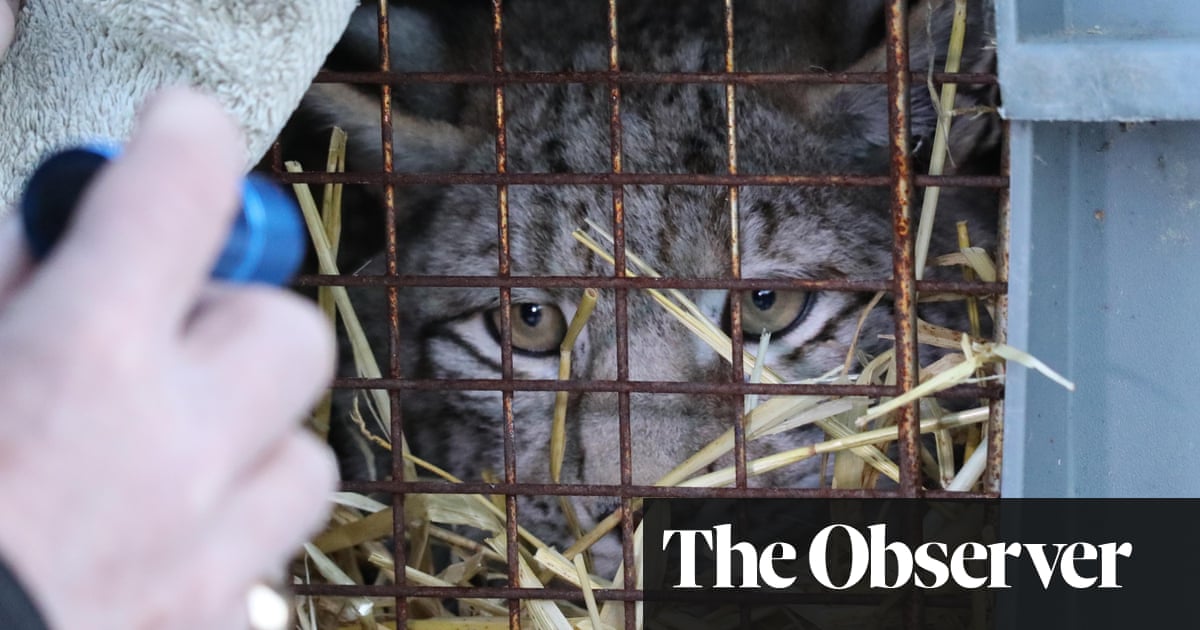
One of the four lynx captured in the Scottish Highlands this week has died. The animal, which had been illegally released, was caught on Friday near Kingussie in the Cairngorms national park.
The Eurasian lynx was one of four that had been discovered running wild in the Dell of Killiehuntly area. Two were captured on Thursday and are being kept in quarantine at Edinburgh zoo. The other pair were trapped the next day and the survivor will join the first two in captivity.
Dr Helen Senn, the head of conservation at the Royal Zoological Society of Scotland (RZSS), said the circumstances behind the death of the lynx were not yet known. “However, we will be carrying out a postmortem to try to establish what happened,” she added.
“Whatever the case, this unfortunate development just serves to further demonstrate the folly of abandoning these amazing animals in the wild, with no preparation or real concern for their welfare. We can only imagine the stress that all four of the recovered lynx must have experienced after being thrust into an entirely new and extremely harsh environment to fend for themselves.”
Temperatures in the area plunged to as low as -14C this week. Usually they hover around 0C at this time of year.
Adult lynx are roughly the size of a labrador and are shy and solitary creatures that very rarely attack humans. The captured animals are also tame and are used to humans, the RZSS said. In the wild, lynx are exceptional hunters with highly sensitive hearing and vision. They feed predominantly on roe deer but will also eat red deer, birds, rabbits, hares, rodents and foxes.
The animal was once native to Britain but habitat loss and hunting drove them to extinction about 1,000 years ago, and their sudden appearance in the wilds of the Cairngorms has startled conservationists. Some believe a frustrated activist who wants to see the lynx returned to Scotland could be responsible for releasing the animals from a private reserve.
In 2021 a group of charities launched a consultation on people’s views about the potential of reintroducing Eurasian lynx to Scotland. Peter Cairns, the director of one of the charities involved, said: “The Lynx to Scotland project is working to secure the return of lynx to the Scottish Highlands, but irresponsible and illegal releases such as this are simply counter-productive”.
This point was backed by David Field, the chief executive of RZSS. “Sadly, there are rogue rewilders out there who bypass all the established international best practices. That’s really sad and that’s a real, real risk,” he said.
The appearance of the animals, Field added, could simply be a case of them being abandoned by someone who no longer wished to look after them.
Steve Micklewright, the chief executive of Trees for Life, another member of the Lynx to Scotland partnership, said: “This sorry saga is a reminder why an official future reintroduction of lynx to the Highlands must be properly managed with habitat assessments, public consultation and a government licence. This would be a huge win for Scotland in the fight against extinction.”
Police Scotland said inquiries into how the lynx ended up in the area were continuing, and officers and wildlife experts will continue to examine the area where the animals were found.
Edward Mountain, a Conservative MSP for the Highlands and Islands region, said the second capture of lynx suggested there had been a concerted approach to reintroduce lynx illegally. “These animals cannot magically appear, and the authorities should be tackling this wildlife crime with an absolute focus on finding out who is responsible.”
Source: theguardian.com


















